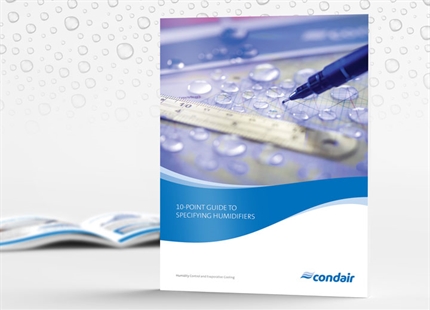04.03.2020
Indoor air is not coronavirus-ready
Oliver Zimmermann, CEO of Condair Group, comments on the lack of humidity control regulations for public places and the subsequent impact on possible coronavirus transmission and the nation’s health.
Building occupants are being exposed to increased risk from viruses, such as the coronavirus, because the regulations on indoor air quality (IAQ) are falling short of current scientific knowledge. Maintaining IAQ at above 40%RH has been scientifically shown to reduce viral cross infection, including coronavirus and influenza. Yet out-of-date regulations on the topic result in buildings such as hospitals, offices and schools experiencing dangerously low humidity levels every winter.
Studies, such as Casanova et al 20101, have specifically examined humidity’s role in coronavirus transmission. This study showed that coronavirus was deactivated fastest when exposed to a mid-range humidity (50%RH), rather than dry (20%RH) or damp (80%RH) air. There are many other studies, dating back from the 40s to now, that all indicate that an indoor humidity of 40-60%RH has a positive impact on cross infection and people’s susceptibility to viruses. Alongside Casanova et al 2010, summaries of 25 other such studies are listed on our website.
The building services sector accepts this indoor humidity level as being best practise, with professional bodies such as BSRIA and CIBSE endorsing a mid-range humidity for health in their recommendations. However, without regulation that determines an acceptable range of indoor humidity for public places, building designers, who are driven to reduce building energy consumption and costs, do not commonly include humidity control in their plans.
The seasonality of viruses, such as coronaviruses and influenza, are further evidence of humidity’s role in their transmission. Indoor air is much drier in the winter and this corresponds to the rise of infections. The government’s coronavirus containment strategy takes into account the fact that infections will probably drop as warmer weather returns, and indoor humidity levels naturally return to a midrange 40-60%RH. It doesn’t need to be this way! A healthy indoor humidity can be maintained during winter if buildings incorporated humidification as part of the ventilation system. This would significantly reduce seasonal ‘flu transmission and save thousands of lives every year.
The government advice on mitigating the risk from coronavirus focuses on hand hygiene and avoiding unwell people. However, viral cross infection occurs via the air as well as from physical contact. As the general public are largely helpless to manage this important aspect of infection control, government advice ignores this topic.
The responsibility to manage IAQ ultimately falls on building owners and operators to safeguard occupant health. This is particularly true with regards healthcare facilities, where people are most vulnerable and at risk to airborne infections, such as coronavirus and influenza.
Nations are being failed in this respect. Design guidelines state that humidity control is not required unless for specific physiological or operational reasons. The guidelines even present the expense of operating humidifiers as the main reason for avoiding humidity control, without any acknowledgement of the benefit it offers for infection control. Guidelines on indoor air quality in schools also state that humidity control is not required and short-term exposure to very low humidity is acceptable.
Given the overwhelming scientific evidence for indoor humidity of 40-60%RH being an effective infection control mechanism, and the pending viral pandemic on our doorstep, what will be the true cost to the nations regulatory bodies’ failure to listen to the science and maintain a healthy indoor humidity?
Reference
1 - Effects of Air Temperature and Relative Humidity on Coronavirus Survival on Surfaces. Lisa M. Casanova, Soyoung Jeon, William A. Rutala, David J. Weber, Mark D. Sobsey. Applied and Environmental Microbiology Apr 2010, 76 (9) 2712-2717; DOI: 10.1128/AEM.02291-09

Oliver Zimmermann, CEO at Condair Group.
Maintaining IAQ at above 40%RH has been scientifically shown to reduce viral cross infection...










